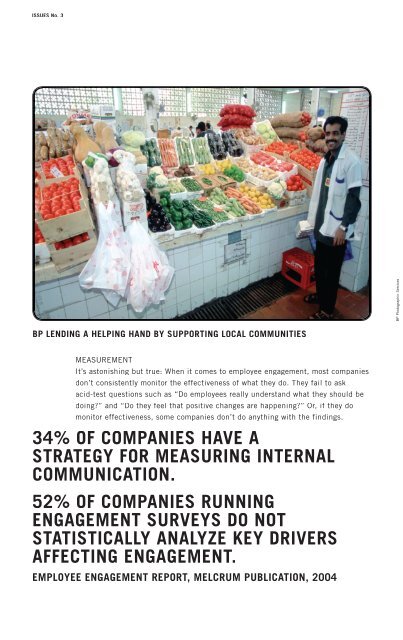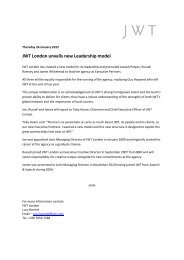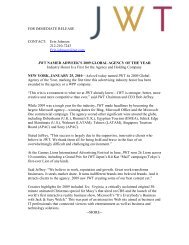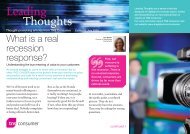Building Brands from the Inside Out - WPP.com
Building Brands from the Inside Out - WPP.com
Building Brands from the Inside Out - WPP.com
- No tags were found...
Create successful ePaper yourself
Turn your PDF publications into a flip-book with our unique Google optimized e-Paper software.
ISSUES No. 3 11CREATING ENGAGEMENTBut what about those weak links, loose cannons and bystanders? Is all this enoughto convert <strong>the</strong>m to true engagement? In some cases, <strong>the</strong> answer is no. Some weaklinks are so disengaged that it’s best for <strong>the</strong> two sides to part <strong>com</strong>pany. O<strong>the</strong>rtimes, weak links have <strong>the</strong> potential to be your biggest champions. They want tobelieve, but <strong>the</strong>y can’t. Often, it’s <strong>the</strong> organization, not <strong>the</strong> employee, that’s atfault. Ensuring that <strong>the</strong>re are <strong>com</strong>pelling and true reasons to believe can helpemployees on <strong>the</strong> journey to be<strong>com</strong>ing a champion. Often, however, what manyemployees actually experience are unconvincing lies or just muddling confusion.AT&T was once one of America’s biggest and most successful <strong>com</strong>panies. Today itssurvival is in doubt and its stock has junk bond status. Throughout its long decline,many attempts were made to launch “a new AT&T.” Dick Martin, former VP of publicrelations, employee <strong>com</strong>munications and brand management, recalls in his bookTough Calls how unsuccessful <strong>the</strong>y all were.5All <strong>the</strong> campaigns’ “focus had beenexternal,” he writes. “They were designed to convince <strong>the</strong> outside world that it hadunderestimated <strong>the</strong> <strong>com</strong>pany.”BP LENDING A HELPING HAND BY SUPPORTING LOCAL COMMUNITIESMEASUREMENTIt’s astonishing but true: When it <strong>com</strong>es to employee engagement, most <strong>com</strong>paniesdon’t consistently monitor <strong>the</strong> effectiveness of what <strong>the</strong>y do. They fail to askacid-test questions such as “Do employees really understand what <strong>the</strong>y should bedoing?” and “Do <strong>the</strong>y feel that positive changes are happening?” Or, if <strong>the</strong>y domonitor effectiveness, some <strong>com</strong>panies don’t do anything with <strong>the</strong> findings.34% OF COMPANIES HAVE ASTRATEGY FOR MEASURING INTERNALCOMMUNICATION.52% OF COMPANIES RUNNINGENGAGEMENT SURVEYS DO NOTSTATISTICALLY ANALYZE KEY DRIVERSAFFECTING ENGAGEMENT.EMPLOYEE ENGAGEMENT REPORT, MELCRUM PUBLICATION, 2004BP Photographic Services“Unless it is preceded by an effective internal campaign,” Martin states, “any suchpositioning program is built on sand. No one outside <strong>the</strong> <strong>com</strong>pany will believe a messagethat is not reflected in <strong>the</strong>ir experiences with <strong>the</strong> <strong>com</strong>pany. And no one inside <strong>the</strong><strong>com</strong>pany will believe a message that does not <strong>com</strong>port with what he sees on <strong>the</strong> jobevery day.” In o<strong>the</strong>r words, weak links are usually products of weak strategies, weakleadership and weak excuses.Sometimes, <strong>the</strong> very mechanics of brand engagement and internal <strong>com</strong>municationcause problems. To work, brand engagement needs to bring <strong>the</strong> CEO, Marketingand Human Resources toge<strong>the</strong>r for a <strong>com</strong>mon cause. But all too often it’s a triggerfor internal turf wars. Marketing, frustrated that employees aren’t delivering on <strong>the</strong>promises <strong>the</strong>y make to customers, wants to muscle in on HR’s patch. HR spies anopportunity to extend its influence beyond <strong>the</strong> routine of recruitment, training,and terms and conditions to be<strong>com</strong>e a “strategic” partner to <strong>the</strong> CEO. Jostling forpower immediately sabotages <strong>the</strong> very thing that’s needed to create engagement—mutually supporting alignment between different levels of management andacross silos.This is no trivial point. When business school researcher Jody Hoffer Gittell setout to understand what set Southwest Airlines apart <strong>from</strong> its U.S. <strong>com</strong>petitors,she found high levels of shared goals, shared knowledge and mutual respect. 6At American Airlines, mutual suspicion among groups of employees was endemic.As one employee remarked: “They all think <strong>the</strong>y’re better than each o<strong>the</strong>r. Gateand ticket agents think <strong>the</strong>y’re better than <strong>the</strong> ramp. The ramp think <strong>the</strong>y’re betterthan <strong>the</strong> cabin cleaners. The cabin cleaners look down on <strong>the</strong> building cleaners.”At Southwest, employee groups were all much more focused on helping one ano<strong>the</strong>rimprove <strong>the</strong> customer’s experience.
















